|
Introduction to New Testament Transmission
Introduction
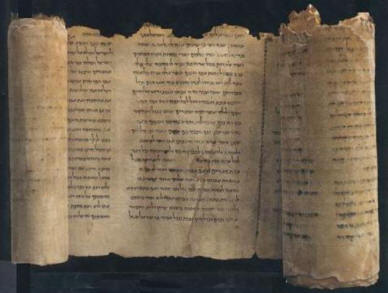 The Old Testament portion of today’s Bible is derived from
Hebrew manuscripts. These manuscripts are copies derived from
the autographs, which originated from 1450 to 425 B.C. The
process of manuscript copying, from generation to generation is
manuscript transmission.
The Old Testament portion of today’s Bible is derived from
Hebrew manuscripts. These manuscripts are copies derived from
the autographs, which originated from 1450 to 425 B.C. The
process of manuscript copying, from generation to generation is
manuscript transmission.
Manuscript transmission is a human process, as
copies are made of copies, originating from an autograph.
Because the process is human and over long periods, copying
variations and errors may occur over time. These “transmission”
errors themselves became part of the text over time, causing
variations in some manuscripts. By examining the manuscripts
themselves, their history and background, we are able to get to
arrive at a clearer understanding of the text of the
autograph. This process of examination, textual criticism,
is defined as the science and art that seeks to determine the
most reliable wording of the biblical text.
In studying the Bible, a distinction needs to be
made between the autograph and the copy of the autograph
(manuscript transmission). Since the copy of the autograph, is
transmitted via human agency, over long periods, variations and
human error have a tendency to appear in the text, the result of
copyist errors. This is in contrast to the autograph, which was
inspired or “God breathed” when it was originally revealed.
Biblical
Inerrancy
The message of the scripture is inspired and
original autograph is inerrant. For the most part, when looking
at variations of between various manuscripts, the effect on the
text is rather minimal. Most variations involve spelling and
grammatical differences between manuscripts with absolutely no
effect on the meaning of the text.
Many people confuse the concept of manuscript
transmission and textual criticism, as evidence the
bible is a book with errors and therefore not inerrant.
First, what does inerrancy mean? The Evangelical Dictionary
of Theology defines Inerrancy;
the view that when a the facts become known, they will
demonstrate that the Bible in its original autograph and
correctly interpreted is entirely true and never false in all it
affirms, whether that relates to doctrine or ethics or to
social, physical or life sciences.
Biblical Inerrancy and textual criticism
The purpose of textual criticism is to restore, as near as
possible the text of the original autograph, by examining the
various manuscripts. Commenting on the extent of variation
between the manuscript sources, Paul Wegner writes,
Bruce
Waltke, former Old Testament professor at Regent College in
Vancouver, Canada, notes in the Biblia Hebraica
Stuttgartensia
one textual notes appears for every ten words; thus 90 percent
of the text is without significant variation. And Shermaryahu
Talmon, from the Hebrew University in Jerusalem, asserts,
“errors and textual divergences between the versions materially
affect the intrinsic message only in relatively few instances.”
Old Testament textual criticism therefore, concerns mainly
details and discrepancies in relatively insignificant matters.
By comparing the various OT manuscripts, we are able
to examine the textual transmission of the Old Testament, and
see if there is corruption in the transmission process.
Textual Criticism
The process of textual criticism begins with a
compilation of the evidence. The main sources of evidence are
the available manuscript readings on the verse. The textual
critic would then weigh the various reading from the
manuscripts. A summary of these main sources are:
|
1 |
The Masoretic Text:
The most authoritative version of the Hebrew scriptures,
which became standardized about A.D. 100, based on
manuscript evidence. The name come from the Masorites
who were scribes from A.D. 500-1000. They carried on
the work of earlier scribes who maintained the Hebrew
scriptures. |
|
2 |
The Samaritan Pentateuch:
Written in paleo-Hebrew, this work only involves the
first five books (Torah), the version could be dated to
the 3rd to 2nd century B.C. The
oldest existing manuscript is dated to the 13th
century. |
|
3 |
The Qumran Manuscripts (Dead Sea Scrolls):
Manuscripts found at the Dead Sea, dating between 250
B.C. to A.D. 50. A portion of every book of the Bible
except has been found at this site. |
|
4 |
Ancient Hebrew Manuscripts:
Other ancient Hebrew manuscripts have been discovered,
in addition to the Dead Sea Scrolls. These include the
Nash Papyrus, Masada, Murabbar’at and the Cairo Genizah). |
|
5 |
The Septuagint:
(250-100 B.C.), the Greek translation of the Old
Testament. |
|
6 |
OT Greek Manuscripts:
Aquila, Symmachus and Theodotion. |
|
7 |
Syriac Peshitta:
Dated to the 1st century A.D. |
|
8 |
Jewish Targums:
Aramaic paraphrase translations of the Old Testament 3rd
and 4th centuries A.D., These translations
have a much older tradition dating back to the time of
Ezra possibly. |
|
9 |
Latin Vulgate: A.D. 390-405,
Latin Translation by Jerome. |
Evaluating the evidence
Once the verse in question is compared against the manuscripts,
the textual critic then begins to evaluate the verse itself,
based on its construction. He would look for:
1. Vowel changes
2. Copying mistakes
Vowel changes
Vowels in Hebrew are a late addition (9th century),
they were added to help the have the correct pronunciation of
the word. If a vowel was pointed incorrectly, it can change the
entire meaning of a word. Pointing are the symbols (points)
used under and over words indicating if the vowel and whether is
long or short.
For example the dog, has the consonants d and
g. These consonants can make up the words, dog, dug,
dag, dig and deg. If you had the following
sentence, “The boy loves his dig.” More then likely, the word
meant here is dog instead of dig.
Copyist errors
No matter how well trained the scribes were, they are still
human, and over time various copyist errors have crept into the
manuscripts. These errors would then follow as the manuscript
was copied and then recopied from generation to generation. Many
of these copyist errors are clearly known and very obvious, many
are noted in the manuscripts themselves. The types of errors
and some examples are below, adopted from Paul Wegner chart:
|
|
Error |
Definition |
Possible examples |
|
1 |
Mistaken letters |
Confusion of similar letters |
Genesis 10:4 cites a race known as the “Dodanim” but I
Chronicles 1:7 calls them the “Rodanim”. |
|
2 |
Homophony |
Substitution of similar sounding words. |
Isaiah 9:2 |
|
3 |
Haplography |
Omission of a letter or word usually due to similar
letter or word in context. |
Judges 20:13 |
|
4 |
Dittography |
A letter or word that has been written twice instead of
once |
Jeremiah 51:3 “yidrok” (he drew) appears 2 times |
|
5 |
Metathesis |
Reversal in order of two letters or words |
Deuteronomy 31:1, Masoretic Text reads “Moses went”,
Qumran reads, “Moses finished”. |
|
6 |
Fusion |
Incorrect word division that results in two words joined
as one |
Leviticus 16:8 |
|
7 |
Fission |
Incorrect word division that results in one word written
as two. |
Hosea 6:5 |
|
8 |
Homoioteleuton |
An omission caused by two words or phrases that end
similarly. |
I Samuel 14:41 |
|
9 |
Homoioarchton |
An omission caused by two words or phrases that begin
similarly. |
Genesis 31:18 |
|
10 |
Other omissions |
Any other omissions. |
The years that Saul reigned are omitted from 1 Samuel
13;1 |
Evaluating the evidence
There are several factors to weigh when you examine the evidence
for a particular verse. The weight of evidence does not lie
with the number of manuscripts but with the weight of
manuscripts. In addition to the manuscript evidence several
other factors need to be taken into account.
1. Language of the witness
2. Date of the witness
3. Reliability of the witness
4. Provenance (Origin/Source) and purpose of the witness
5. Interdependence of the witness.
Old Testament Manuscripts, sources of textual criticism
|
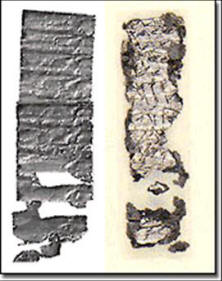 |
Silver Amulets
These are the oldest existing Old Testament texts in
existence. They were found in a grave, near St. Andrew’s
church of Scotland at Jerusalem, south of the walls of
Jerusalem about one mile. They quote numbers 6:22-27,
the priestly benediction, they are similar to the
Masoretic Text. They are dated to about 850 B.C.,
amulets like these were worn as charms on the arms or
neck to protect against evil. The fact they are made out
of rolled thin silver preserved them to this point. The
large one measures 4 inches by 1 inch, the other one is
1 inch by ½ inch. |
|
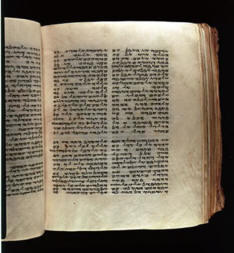 |
Samaritan Pentateuch
In 722 B.C., the Assyrians removed 22,290 Israelites and
replaced them with other people from conquered Assyrian
lands. These foreigners mixed with the remaining
population of Israel and became known as the
Samaritans. They were considered half-breeds by the
Jews of Judah, when the Jews returned after the
Babylonian captivity in 539 B.C., the Samaritans were
not allowed to help rebuild the Temple. So the
Samaritans built their own Temple on Mt. Gerizim.
With the split of the Samaritans from the Jews
from the 8th century B.C., there arose a second Hebrew
revision of the Pentateuch, known as the Samaritan
Pentateuch. It contains the five books of Moses and is
written in Paleo-Hebrew script similar to the that found
on the Moabite Stone, Siloam inscription.
Author Frank Cross believes the Samaritan
Pentateuch branched off in the Pre- Masoretic text in
the 2nd century BC.
The differences from the Masoretic text are
trivial and orthographic. The Samaritan Pentateuch
differs from the Masoretic text in about 6000 places,
most are spelling and grammatical in nature. Sixteen
hundred of these differences agree with the Septuagint.
Some of the differences were introduced by
Samaritans with the interest in preserving their status.
Such as the location of the Arc. The oldest existing
manuscript is dated to the 11th century AD.
|
|
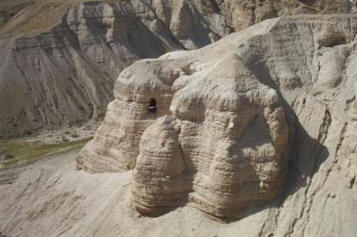
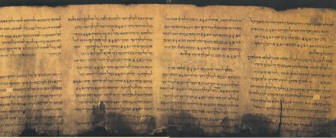 |
Dead Sea Scrolls (Qumran Manuscripts)
Dead Sea Scrolls
In March 1947 a young Arab boy discovered in the caves
of Qumran near the Dead Sea jars containing several
leather manuscripts dating to the time of Christ. They
belonged to the Essenes. The Essenes were a Jewish sect
that settled in the Judean desert, near Qumran. Other
manuscripts were found over the next 10 years. Two
copies of the book of Isaiah were found along with books
and fragments from the whole Old Testament except for
the book of Ester.
Prior to the discovery the oldest existing
book of the Hebrew Old Testament dated to about 1000
AD. Carbon dating has placed them between 168 BC and
233 AD. Archaeology puts the dates at between 150 BC to
100 AD.
Gleason Archer observed that the two copies
of Isaiah proved to be word for word, identical with
our standard Hebrew Bible in more than 95% of the text.
The 5% of variation consisted chiefly of obvious slips
of the pen and variations in spelling. The scrolls gave
an overwhelming confirmation of the Masoretic text.
Some of the variants show parallels to the Greek text of
the Septuagint (LXX).
The Dead Sea Scrolls are owned by the Nation of Israel
|
|
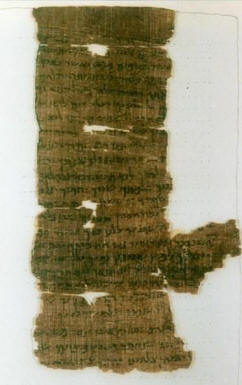 |
Nash Papyrus
In 1902 W.L. Nash acquired a damaged copy of the 10
commandments from an Egyptian dealer, he donated them to
Cambridge University. This manuscript has been dated to
the Maccabean period by William F. Albright (169-37
B.C.). Paul Kahle places its origin before the
destruction of the Temple in A.D. 70.
This scroll seems to be a combination of texts from
Exodus 20:2-17 an Deuteronomy 5:6-21 and may have been
used for another purpose, rather then just a text. |
|
 |
Murabba’at Manuscripts
Excavated in January 1952, caves found 11 miles south of
the Dead Sea site, manuscripts were found dating to the
time of the Simon bar Kochba revolt, (A.D. 132-135).
Archeologists found in Cave 2, fragments from the books
of Genesis, Exodus, Numbers, and Deuteronomy, along with
Isaiah. Also one of the oldest papyrus manuscripts of
the minor prophets was discovered, this manuscript was
nearly identical to the Masoretic Text, affirming a
standardization of the text by the 2nd
century, only three variants existed. |
|
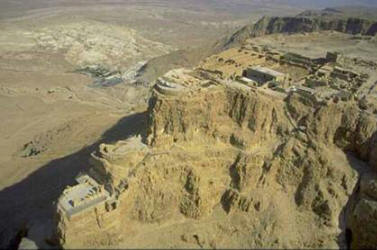 |
Masada
Herod constructed a palace at Masada (36-30 B.C.),
located along the Dead Sea. The 1300-foot walls create
a natural fortress. Masada was the last scene of the
Jewish revolt against the Romans in the first revolt in
A.D. 66-73. The occupants held out until the Romans
used forced Jewish labor to build a ramp. As the Roman
10th legion, led by Flavius Silva was about
to enter, the Zealots who occupied Masada, committed
suicide.
Manuscripts found at the site during
excavations 1963-1965 include Genesis, Leviticus,
Deuteronomy, Psalms and Ezekiel. These documents were
dated prior to A.D. 73. |
|
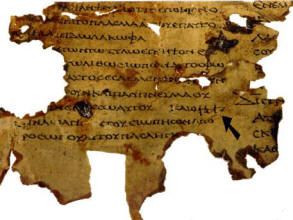 |
Wadi Habra
Located one the western shore of the Dead Sea, one mile
south of Ein Gedi, in 1952 fragments of Genesis,
Numbers, Deuteronomy and Psalms were found. One of the
more amazing discoveries was a Greek translation of the
Minor prophets, which used the ancient Hebrew script,
for the Lord’s name in the Greek text. These manuscripts
dated to A.D. 132, were virtually identical with the
Masoretic Text. |
|
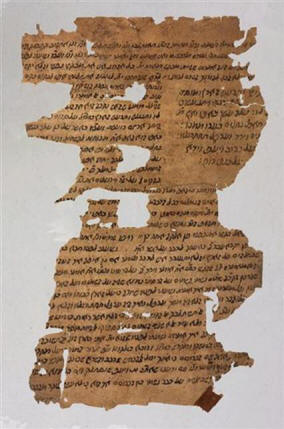 |
Genizah fragments
The Ben-Ezra Synagogue in Cairo Egypt was built in 1015,
in Old Cairo. Located in the attic was the Genizah or
storage room, which had no walls or windows and was only
accessable by a hole in the western wall.
The room was discovered in 1860, and from that point
manuscripts made their way to Europe. Some estimates put
the number of manuscripts and fragments at 200,000.
Most manuscripts dated from 1000 to 1400, some however,
were dated much earlier.
The most important manuscripts included biblical
manuscripts dated to the 5th century. The
Zadokite Document, also known as the Damascus Document.
And a Hebrew version of the Wisdom of Ben Sirach, prior
to this only Greek texts were in exisitence. |
|
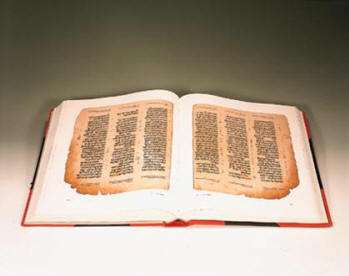 |
Codex Cairenis (C )
This manuscript was preserved by the Karaite
Community of Cairo, and contains only the former and
Later prophets. The codex seems to have been written
and pointed by Moses ben Asher in Tiberias for Yabes
ben Shelomo in A.D. 895, a Karaite Jew. |
|
.jpg) |
Aleppo Codex (A)
The Aleppo Codex dates from the Masoretic period, of
Old Testament copying. During this period there was a
deep reverence of the Scriptures, complete review of
established rules and a systematic renovation of
transmission techniques. During the crusades July 15,
1099 it was taken as plunder, but seven years it was
returned to the Karaites, who then brought it their
community at Cairo.
Aleppo was written by Shelomo ben Baya’a but according
to a colophon it was pointed (vowel marks were added) by
Moses ben Asher (930 A.D.) It is a model codex based on
the Masoretic text. It was not permitted to be copied
for a long time and was reported to be destroyed.
Aleppo Codex was smuggled from Syria to Israel. It has
now been photographed and will be the basis of the New
Hebrew Bible to be published by Hebrew University. It
is a sound authority for the Ben Asher text.
|
|
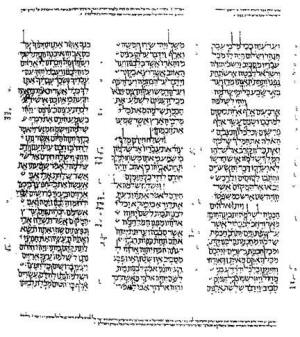 |
Codex Leningradensis
This manuscript is dated A.D. 1008, and was pointed by
the ben Asher family. This manuscript was the source
for the Biblia Hebraia, edited by R. Kittel ( 1929-1937)
version of the Old Testament, and used by most recent
translations of the Old Testament today.
|
|
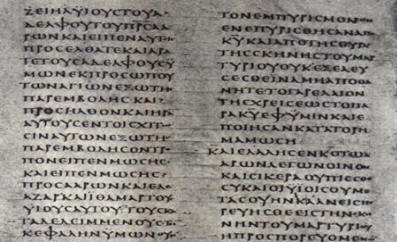 |
The Septuagint or the LXX
The LXX version is the first translation of the OT ever
made. The translation was inaugurated by Ptolemy of
Philadelphus (285-247 BC). Ptolemy was fond of books and
wanted to add the Hebrew Pentateuch to his collection in
Alexandria. The LXX was the bible of the early church.
The order of OT books is derived from the LXX through
the Latin Vulgate translated by St. Jerome.
On the basis of the LXX Catholics advocate
the “Larger” canon of the Jews in Alexandria.
Protestants deny the existence of an independent canon
in Alexandria, in view of the “smaller” canon of the
Jews in Palestine. The difference is 7 complete books
and portions of 2 others. The books are Tobit, Judith,
Wisdom, Sirach, Baruch, I & 2 Macabees and additions to
Daniel and Esther.
These portions are rejected by protestants.
The oldest existing LXX manuscripts is dated to the mid
4th century, they are Sinaticus and Vaticanus
Codexs.
|
|
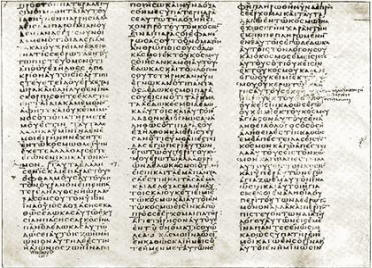 |
Codex Vaticanus
Dated to the 4th century, contained all the
Old Testament at first, portions are missing today.
Missing are Genesis 1-46:28a, 2 Samuel 2:5-7, 10-13;
Psalms 105[106]:27-137 [138]:6b; There are 617 leaves
for the Old Testament, each leave bearing three columns
with black ink, written on calf skin (velllum). This
was cataloged in the Vatican library in 1471 or 1481,
but was not available for viewing.
Napoleon carried off this codex to Paris was war
booty, it was returned after his death in 1815.
Constantin von Tischendorf (1815-1874) viewed the
document for a few hours in 1867, and published an
edition. The Vatican released photographs of the leaves
in 1889/90. |
|
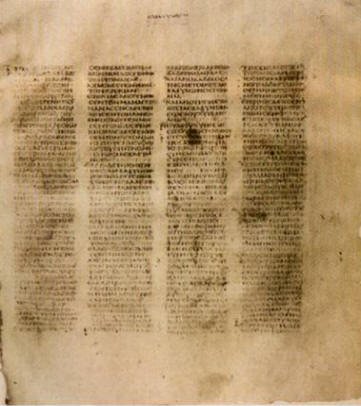 |
Codex Sinaticus
This version of the Septuagint contains only half of the
Old Testament. Dated the 4th century, the
story of its discovery is amazing in its own right. In
1844, Count von Tishchendorf was at St. Catherines
monastery, at Mt. Sinai, in the Library, when he noticed
the monks using manuscripts leaves to keep a fire
burning. He later saw they were Septuagint Greek
manuscripts. He was able to secure the remaining
leaves, he was informed two baskets had already been
burned.
In 1853, he returned not finding any more
manuscripts. Again he returned in 1859, with a letter
from czar Alexander II of Russia, he was shown Sinaticus
but was not allowed to purchase it. Later , the monks
gave it to Tishchendorf as a gift, because the czar
influence over St. Catherines. In 1863, he published
Codex Sinaticus. In 1933, Russia sold the manuscript to
the British Museum for 100,000 pounds.
|
|
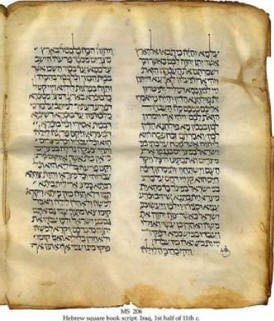 |
The Targums
The Targums are Aramaic translations of the Old
Testament. After the Jews returned from Babylon in 539
B.C., many had lost the ability to communicate in
Hebrew, which became the sacred language of priests and
scribes. Aramaic was the common language. To help Jews
understand scripture, a vernacular version of the
scriptures was assembled, which was varied from literal
to paraphrase in the quality of translations.
Targum Onqelos
was very literal and became stand for the Pentateuh.
Targum of Jonathan ben Uzziel became standard for
the prophets.
The Targums are viewed more as commentaries more
then translations because of their interpretive nature.
They reflect the Masoretic Text in their translation,
and allow us to see how the rabbis applied scripture.
Targums exist for every book of the Old Testament
except for Daniel, Ezra and Nehemiah. |
|


 The Old Testament portion of today’s Bible is derived from
Hebrew manuscripts. These manuscripts are copies derived from
the autographs, which originated from 1450 to 425 B.C. The
process of manuscript copying, from generation to generation is
manuscript transmission.
The Old Testament portion of today’s Bible is derived from
Hebrew manuscripts. These manuscripts are copies derived from
the autographs, which originated from 1450 to 425 B.C. The
process of manuscript copying, from generation to generation is
manuscript transmission. 









.jpg)




